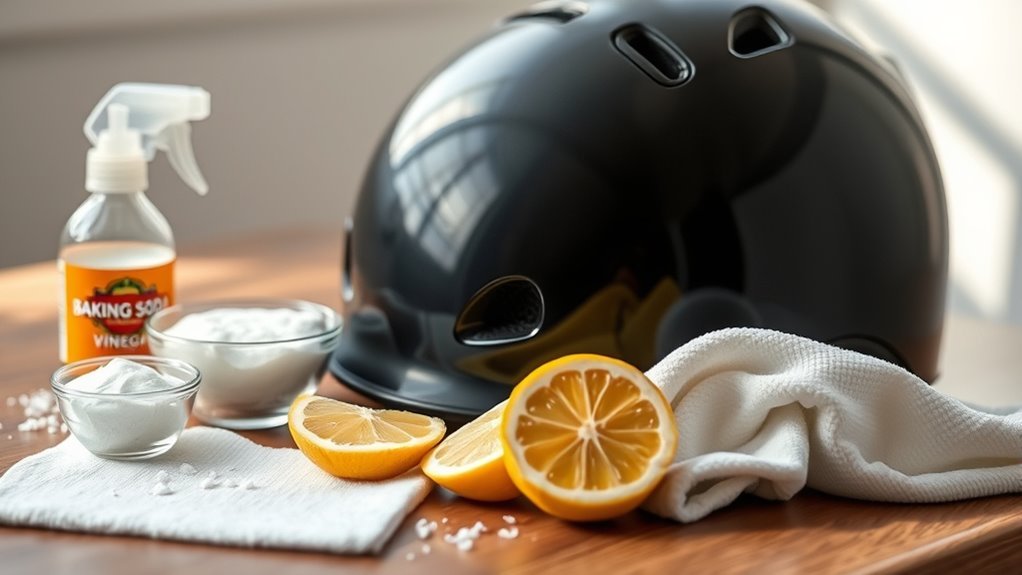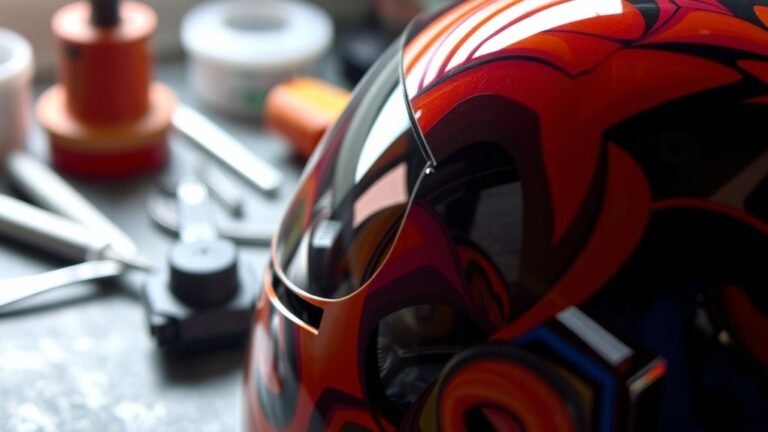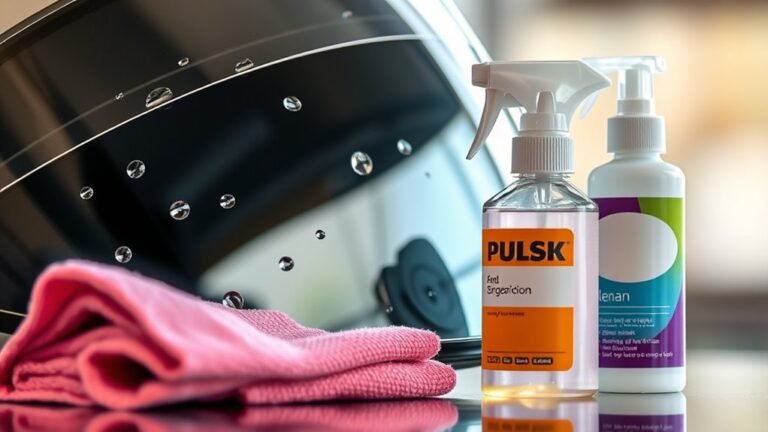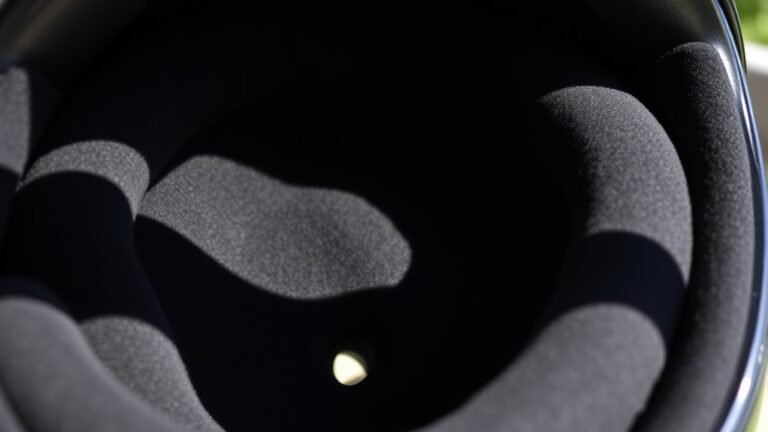How to Remove Odors From Your Helmet
To remove odors from your helmet, start by understanding that sweat and bacteria are the main causes of smells. Clean your helmet regularly by wiping the shell and washing removable padding with mild soap. For deep cleaning, use antibacterial solutions and a soft brush, ensuring thorough rinsing. Consider using natural deodorizers like baking soda or vinegar for effective odor neutralization. Proper storage and maintenance also play a key role in preventing future odors. You’ll discover more tips to keep your helmet fresh ahead.
Understanding the Causes of Helmet Odors

When you wear a helmet, sweat and moisture can accumulate, creating an environment for bacteria and fungi to thrive, which ultimately leads to unpleasant odors. This sweat buildup provides the perfect breeding ground for bacteria growth, particularly when helmets are not properly ventilated. The combination of heat and humidity inside the helmet accelerates microbial activity, resulting in persistent smells that can be hard to eliminate. Additionally, factors such as the material of the helmet liner and how often you use it can exacerbate odor issues. To maintain a fresh and breathable atmosphere inside your helmet, understanding these factors is essential. This knowledge empowers you to take proactive measures to prevent odor development, ensuring a more enjoyable riding experience.
Regular Cleaning: The First Step

Accumulated sweat and moisture not only contribute to odor but also create a buildup of dirt and grime that can further exacerbate the problem. To maintain proper helmet hygiene, regular cleaning is crucial for effective odor prevention. Start by removing any removable padding and wash it according to the manufacturer’s instructions. For the helmet shell, use a damp cloth with mild soap to wipe down the surfaces. Pay special attention to ventilation holes where debris can accumulate. Rinse thoroughly and allow everything to dry completely before reassembling. By committing to this routine, you’ll not only extend the life of your helmet but also guarantee a fresher, more enjoyable riding experience. Regular cleaning is your first line of defense against unwanted odors.
Choosing the Right Cleaning Products
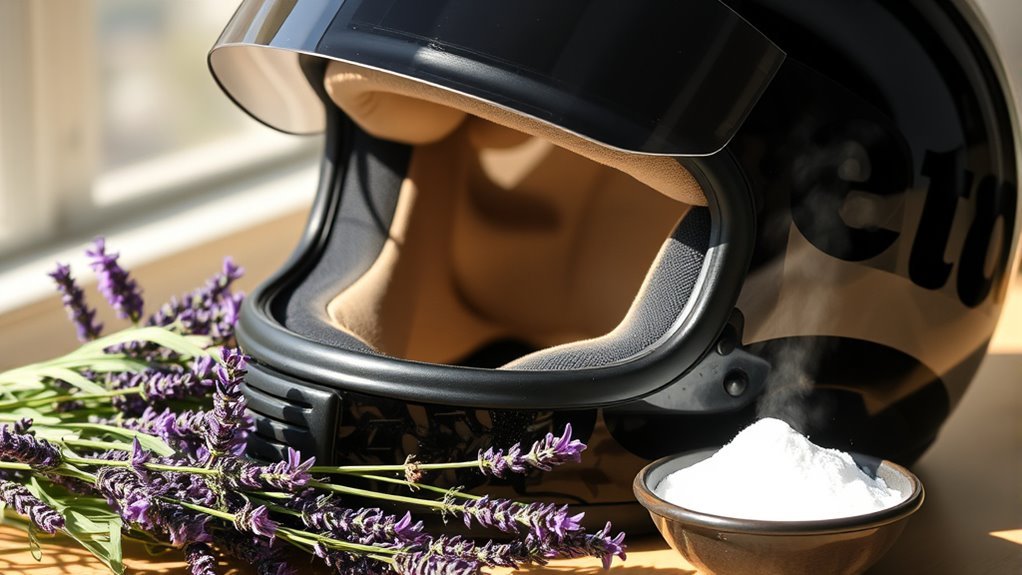
Choosing the right cleaning products for your helmet is essential to effectively combat odors without damaging the materials. Opt for cleaners that feature natural ingredients, as they’re less likely to irritate your skin or harm the helmet’s integrity. Look for eco-friendly options that avoid harsh chemicals, which can degrade the helmet over time. Products with vinegar or baking soda can neutralize odors while being safe for the environment. Always check for compatibility with your helmet’s materials to guarantee you’re making a wise choice. Additionally, consider using biodegradable wipes for a quick clean-up on the go. By selecting the right products, you maintain your helmet’s performance and extend its lifespan, allowing you the freedom to ride without worry.
Deep Cleaning Your Helmet Interior
To effectively deep clean your helmet interior, you’ll need specific cleaning supplies tailored for the task. We’ll outline a step-by-step cleaning process that guarantees thorough sanitation while preserving your helmet’s materials. Additionally, proper drying and maintenance tips will help you keep your helmet fresh for longer.
Essential Cleaning Supplies Needed
When tackling the task of deep cleaning your helmet’s interior, having the right supplies on hand is essential for effective odor removal and hygiene. Start with basic cleaning tools like soft brushes, microfiber cloths, and sponges to gently scrub surfaces without causing damage. You’ll also need a bucket for mixing solutions and a spray bottle for easy application. For odor eliminators, opt for enzymatic cleaners or specialized helmet sprays designed to neutralize unpleasant smells. Avoid harsh chemicals that could compromise your helmet’s materials. Finally, having a good-quality antibacterial soap will help eliminate bacteria, contributing to a fresher environment. With these supplies, you’re well-equipped to restore your helmet and enjoy your rides without unwelcome odors.
Step-by-Step Cleaning Process
A thorough cleaning process for your helmet’s interior involves six essential steps that guarantee effective odor removal and hygiene. Follow these steps to tackle odors and make certain your helmet materials remain intact.
| Step | Action | Purpose |
|---|---|---|
| 1 | Remove Pads | Access the interior for deep cleaning. |
| 2 | Rinse | Remove surface dirt and debris. |
| 3 | Clean with Solution | Break down odor-causing bacteria. |
| 4 | Scrub Gently | Preserve helmet materials while ensuring thoroughness. |
| 5 | Rinse Again | Eliminate cleaning solution residue. |
| 6 | Air Dry | Promote odor prevention by eliminating moisture. |
Drying and Maintenance Tips
After completing the cleaning process, the next focus is on drying and maintaining your helmet’s interior to guarantee it remains odor-free and hygienic. Start with effective drying techniques, such as placing the helmet in a well-ventilated area away from direct sunlight, which can warp materials. You can also use a fan to expedite the drying process, ensuring moisture is fully eliminated.
For maintenance routines, regularly inspect the interior for any signs of wear or persistent odors. Consider using antimicrobial sprays designed for helmets that help prevent bacteria growth. Additionally, remove and wash padding as needed, following manufacturer instructions. By integrating these techniques and routines, you’ll extend the life of your helmet while keeping it fresh and ready for your next adventure.
Dealing With Stubborn Stains
When you encounter stubborn stains on your helmet, it’s essential to identify the type of stain first, as this determines the best cleaning approach. Different stains, such as grease or sweat, require specific solutions for effective removal. Knowing the right cleaning products can save you time and preserve the integrity of your helmet materials.
Identify Stain Types
Identifying the type of stains on your helmet is essential for effectively tackling stubborn odors. There are several odor types associated with different stain sources. Sweat stains typically result from moisture and body oils, while food or beverage spills can leave greasy marks that attract bacteria. If you’ve dropped your helmet outdoors, dirt or mud stains might be present, harboring their own unique odor types. Inspect your helmet closely to pinpoint these stains; the identification process helps you choose the right cleaning methods later. Always note the location and size of each stain, as this will guide your cleaning approach. By understanding stain identification, you can better prepare to eliminate both the stains and the odors they produce.
Effective Cleaning Solutions
To effectively tackle stubborn stains and odors on your helmet, it’s essential to choose the right cleaning solutions. Regular maintenance helps in odor prevention, while using effective products can deal with tough stains.
Here’s a quick guide to help you select the right cleaning solution based on your helmet type:
| Helmet Type | Recommended Cleaner | Cleaning Frequency |
|---|---|---|
| Bicycle | Mild soap and water | Every 2 weeks |
| Motorcycle | Specialized helmet cleaner | Monthly |
| Snowboarding | Vinegar solution | After every use |
| Skateboarding | Alcohol wipes | Weekly |
Drying Your Helmet Properly
Although you might be keen to use your helmet again, proper drying is essential to prevent odors and bacteria from developing. Start by removing any padding and inserts, as they trap moisture. Place your helmet in a well-ventilated area, ideally in indirect sunlight, to encourage proper ventilation. Avoid using heat sources like hair dryers, as they can damage the materials. For effective moisture control, consider using a fan to increase air circulation. Let the helmet dry completely for at least 24 hours before reassembling the padding. Regularly drying your helmet after each use will help maintain its integrity and prevent unpleasant smells, allowing you to enjoy your rides without concern.
Using Natural Deodorizers
If you’re looking for effective ways to eliminate odors from your helmet, natural deodorizers can be a simple yet powerful solution. Consider using baking soda, a well-known natural remedy. Sprinkle it inside your helmet and let it sit overnight; it’ll absorb unwanted smells. Another option is white vinegar, which can neutralize odors without harsh chemicals. Mix equal parts vinegar and water, spray it inside, and allow it to dry. Essential oils, such as tea tree or lavender, also work well. Just a few drops on a cotton ball placed inside can impart a fresh scent. These DIY solutions not only combat odors but promote a healthier helmet environment, aligning with your desire for freedom and sustainability.
Maintaining Freshness With Regular Care
Maintaining freshness in your helmet is essential, especially since regular use can lead to the buildup of sweat and bacteria. Here are some freshness tips to help you with odor prevention:
| Action | Frequency |
|---|---|
| Wipe interior with a cloth | After each use |
| Air out helmet | Daily |
| Wash removable pads | Weekly |
| Use odor-neutralizing spray | Bi-weekly |
| Inspect for damage | Monthly |
Storing Your Helmet to Prevent Odors
Properly storing your helmet is vital for preventing odors and prolonging its life. To guarantee proper helmet placement, store it in a cool, dry location away from direct sunlight. This helps maintain its shape and integrity. Humidity control is essential; high moisture levels can foster bacteria and mold growth, leading to unpleasant smells. Consider using a helmet bag with moisture-wicking properties or placing silica gel packets nearby to absorb excess humidity. Avoid stacking items on top of your helmet, as this can distort its structure. Finally, remember to keep the interior ventilated; placing it on a shelf or dedicated hook can enhance air circulation and further minimize odor development. Proper storage habits can keep your helmet fresh and functional.
Frequently Asked Questions
Can Helmet Odors Affect My Health?
Yes, helmet odors can affect your health. The odor sources, like bacteria and sweat, can lead to respiratory issues or skin irritations if left unchecked. Prolonged exposure to these odors may also increase the risk of infections, particularly in sensitive individuals. It’s crucial to maintain proper hygiene and regularly clean your helmet to minimize these health risks. Staying proactive guarantees you enjoy your activities without compromising your well-being.
How Often Should I Clean My Helmet?
You should clean your helmet every few weeks, especially after intense rides. Picture that fresh, clean scent as you put it on, free from stale sweat. Regular cleaning frequency not only keeps your gear looking sharp but also aids in odor prevention, ensuring you’re always ready to hit the road. Remember, a well-maintained helmet enhances comfort and safety, letting you enjoy the freedom of the ride without distractions.
Is It Safe to Machine Wash My Helmet?
It’s generally not safe to machine wash your helmet. Doing so can damage the inner padding and compromise the helmet’s integrity. For proper helmet care, follow the manufacturer’s washing guidelines, which usually recommend spot cleaning or hand washing with mild soap. This helps maintain the helmet’s shape and safety features. Remember, a well-maintained helmet guarantees your safety while riding, so take the time to clean it properly without using a washing machine.
What Materials Are Best for Helmet Liners?
Foam liners are commonly used in helmets for their shock-absorbing properties, providing essential impact protection. Additionally, incorporating moisture-wicking fabrics enhances comfort by drawing sweat away from your skin, keeping you dry during rides. When selecting helmet liners, look for those that combine these materials, as they offer both safety and comfort. This combination allows you to enjoy your ride while minimizing discomfort from sweat and heat, promoting a more liberating experience.
Can I Use Essential Oils to Remove Odors?
You can definitely use essential oils for odor elimination! Essential oil benefits include their antimicrobial properties, which help combat bacteria causing unpleasant smells. By mixing a few drops of your favorite oil with water in a spray bottle, you can create a natural odor-eliminating solution. Just remember to test it on a small area first. Combine this technique with regular cleaning, and you’ll enjoy a fresher, more pleasant experience every time you wear your helmet.
